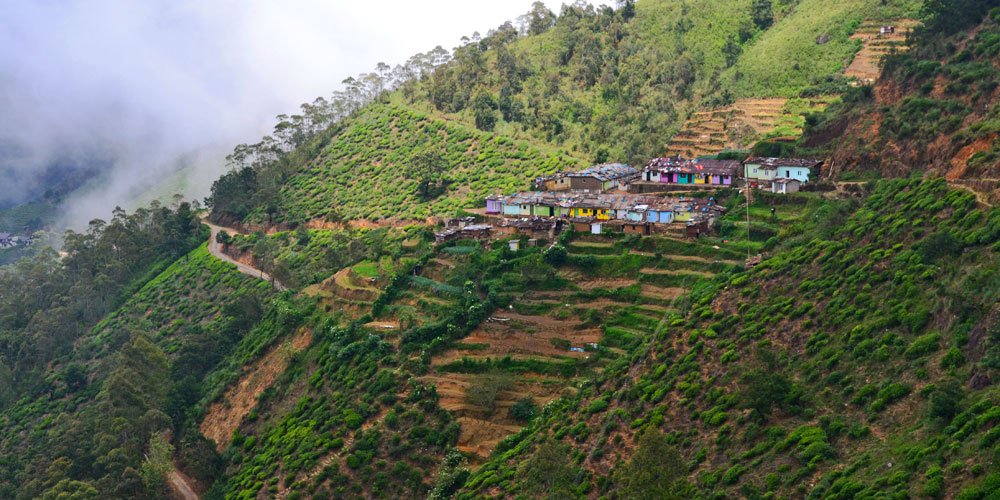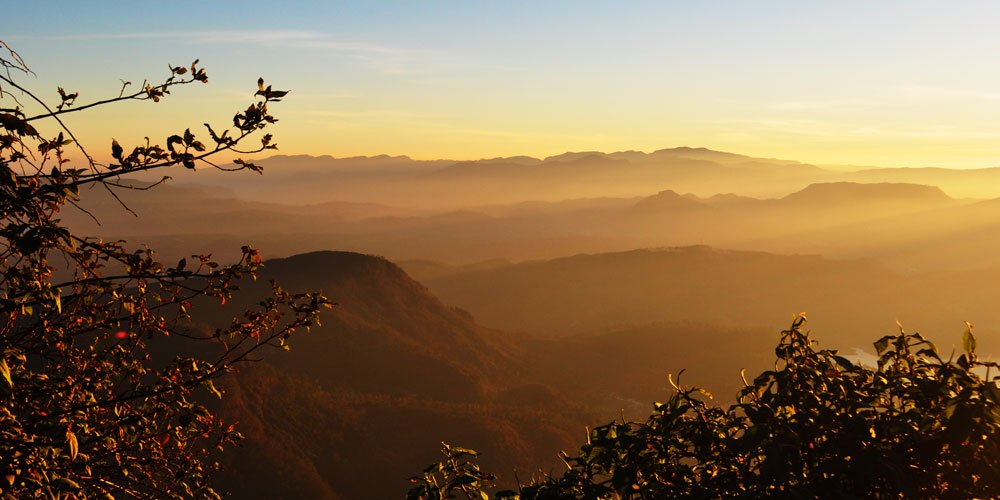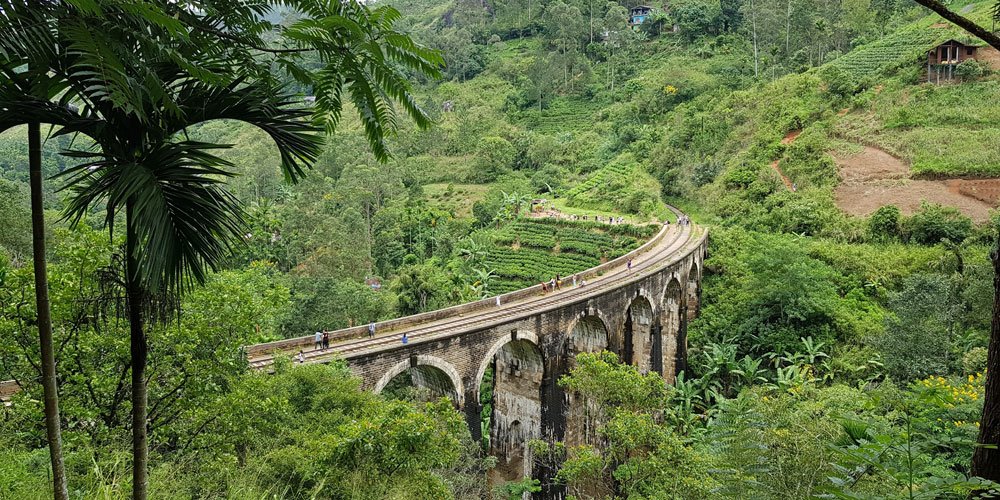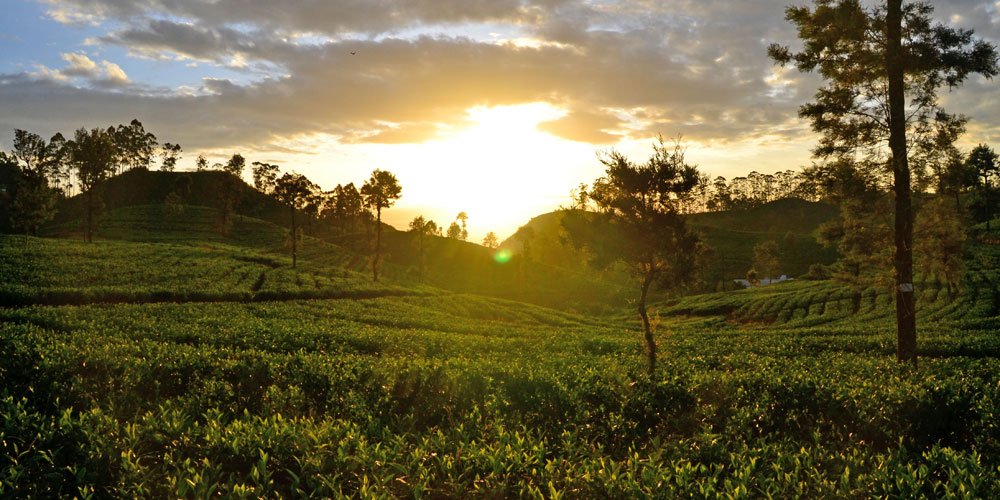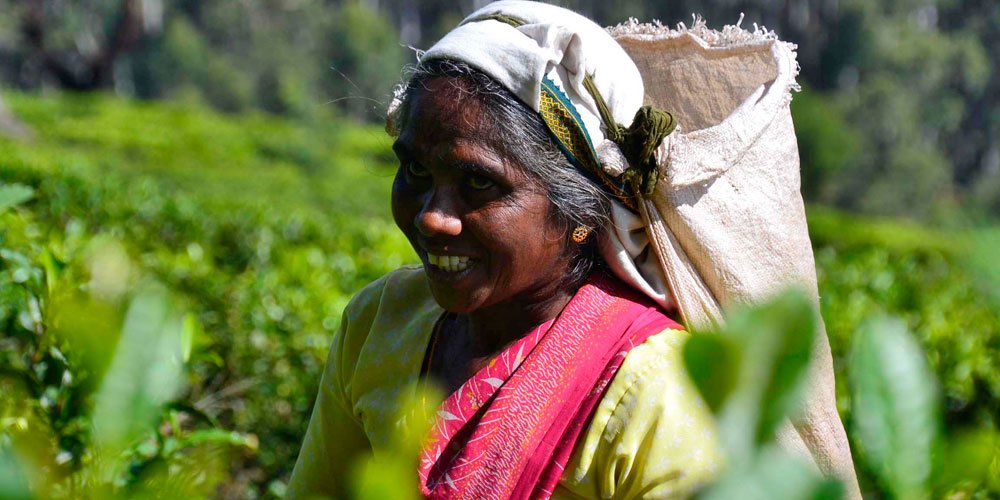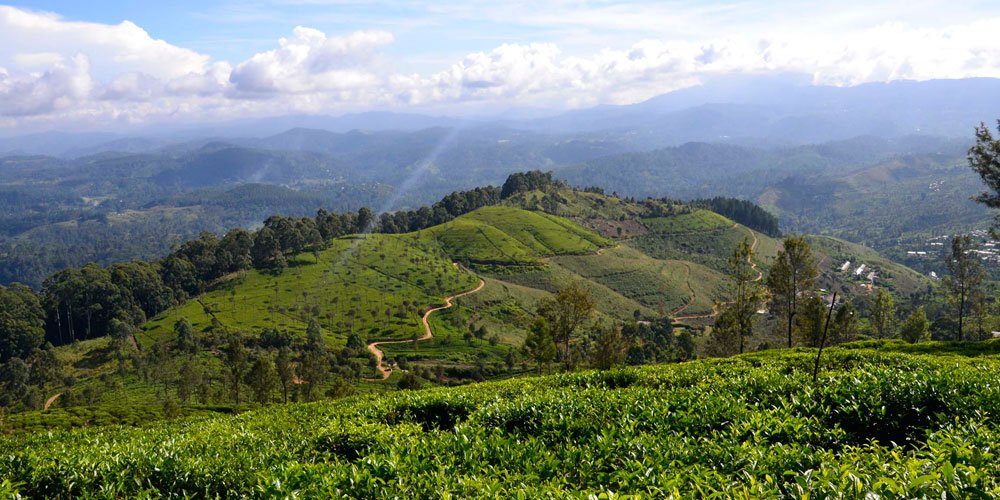The sublime green heights of the hill country are a world away from the sweltering coastal lowlands – indeed nothing encapsulates the scenic diversity of Sri Lanka as much as the journey by road or rail to the cool altitudes of Haputale or Nuwara Eliya.
The hill country is largely a product of the British colonial era when tea was introduced to the island, an industry which continues to shape the economy and scenery of the region today. At the heart of the tea-growing uplands lies the town of Nuwara Eliya, which preserves a few quaint traces of its British colonial heritage and provides the best base for visiting the misty grasslands of Horton Plains and World’s End.
To the south, a string of small towns and villages – Ella, Bandarawela and Haputale – offer marvellous views and walks through the hills and tea plantations. At the southwestern corner of the hill country lies the town of Ratnapura, the island’s gem-mining centre, Uda Walawe National Park, home to one of the island’s largest elephant populations, and Adam’s Peak, whose rugged summit, imprinted with what is claimed to be the Buddha’s footprint, remains an object of pilgrimage for devotees of all four of the island’s principal religions.
Don't Miss
- Dramatic Adam’s Peak
- A charming village and a breathtaking view at Ella
- The haunting World’s End
- Tea plantations up to Lipton’s Seat
Sights in and around the Hill Country
Top things to do in the Hill Country
HAPUTALE
One of the most spectacularly situated of all Sri Lankan towns, Haputale is surrounded by hills covered with cloud forests and tea plantations. The town has a cooler climate than its surroundings, due to its elevation.
Haputale now mainly shows the influence of the Sinhalese and Tamil cultures, but the legacy of the British tea planters also lives on. Tea estates blanket the hillsides, punctuated by graceful planters’ bungalows, all enveloped in a damp and heavy climate that must have made the British settlers feel right at home.
Lipton’s Seat
Lipton’s seat is the highest point of the mountain range around Haputale, where the most famous Tea planter of Ceylon, Sir Thomas Lipton used to admire and enjoy the panoramic view. It is undoubtedly one of the best viewing points of Sri Lanka. It is said that on a clear day, a visitor can see five provinces of Sri Lanka.
Dambatenne Tea Factory
East of Haputale, a 10km scenic road through beautiful rambling tea estates is Dambatenne Tea Factory, built in 1890 by Sir Thomas Lipton. Take a tour through the factory, to be educated on the processes involved in the fermentation, rolling, drying, cutting, sieving and grading of tea. In spite of the on-going modernisation, some of the machinery of the colonial era is still in operation in this ISO certified factory.
Adisham bungalow
Adisham bungalow is a magnificent construction of colonial time which was made by a British governor at 1931, situated 2km from the town. Adisham sits atop a hill amidst the rose garden and orchard, against breathtaking views of Haputale mountains with shrouds of mist wafting in, amidst the cool breeze. At present, it houses the Adisham monastery of Saint Benedict.



NUWARA ELIYA
Sri Lanka’s highest town, Nuwara Eliya is considered to be the most important location for tea production, with its picturesque landscape and temperate climate.
Nuwara Eliya’s climate lent itself to becoming the prime sanctuary of the British civil servants and planters in Ceylon. Nuwara Eliya, called Little England then, was also a hill country retreat where the British colonialists could immerse in their pastimes such as fox hunting, deer hunting, elephant hunting, polo, golf and cricket.
Hakgala Botanical Garden
Hakgala Botanical Garden is the second largest botanical garden in Sri Lanka and is famous for a number of species of orchids and roses. The garden was established in 1861, as an experimental cultivation of Cinchona, a commercial crop thriving at the time. In 1884 it was transformed into a garden. Since then many subtropical and some temperate plants were planted in the gardens. There are over 10,000 species of flora planted and during the Spring season in Nuwara Eliya, thousands of visitors come to see the blooms.
Gregory Lake
Lake Gregory is one of the significant tourist attractions in Nuwara Eliya. It was built by Governor William Gregory during 1872–1877 and is about 91.2 hectares in extent. It was said to be used for water sports during the British rule. Visitors can go boating and rowing, today.
Nuwara Eliya Golf Club
Spread over 90 acres, over a hundred years old (built in 1891), the 18 holes golf course is one of Nuwara Eliya’s biggest attractions. It is reputed to be the only Golf Course where all the holes are visible from the Club House or accessible by car. In the old British cemetery at the rear of the Club House is the memorial to Major Rogers, the elephant hunter credited with killing around 1500 elephants.
Lover’s Leap Waterfall
There is a famous legend behind the name of this waterfall. It says that a Prince who lived in Nuwara Eliya had met a beautiful girl in a nearby village and fallen in love with her. But the king did not allow the Prince to carry on with his love affair. The Prince suffered by his father’s ruling and later on one full moon day he had climbed up the top of the rock with his fiancée and jumped on the fall. Since then it was known as the lover’s leap. You can see this wonderful falls when looking at Pidurutalagala Mountain, it is about 30 meters high and falls off from a huge rock.
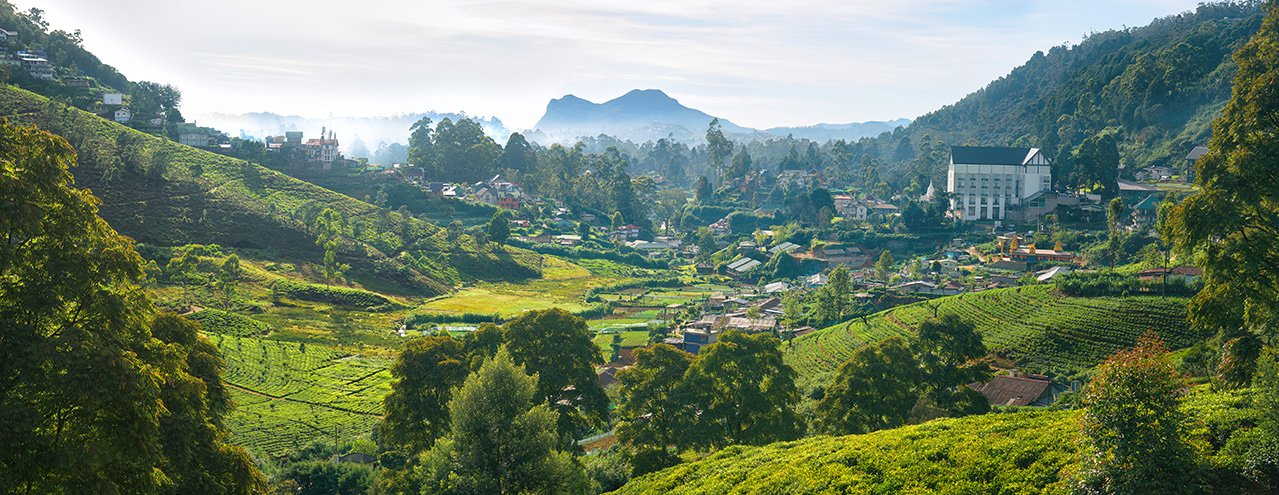
HORTON PLAINS & WORLD’S END
Perched on the edge of the hill country, Horton Plains National Park covers a wild stretch of misty and rainswept grassland. The plains are a beautiful, silent, strange world with some excellent hikes. This plateau at an altitude of 2,100 metres (6,900 ft) is rich in biodiversity and many species found here are endemic to the region. It is also a popular tourist destination and is situated 32km from Nuwara Eliya. The average temperature in this area is about 16 C, with high winds in the evening it can be quite chilly.
Large herds of Sri Lankan sambar deer inhabit the park and its also an important bird area with many species not only endemic to Sri Lanka but restricted to the Horton Plains. Wild boars and leopards can also be found in this area.
World’s End
The walk to World’s End is 4km, where the southern Horton Plains suddenly ends and drops off to nearly 1050 meters – an awesome sight indeed. This shear drop offers a breathtaking view of the land below and even to the Indian Ocean on clear days. This is a favourite place for trekkers, as there are plenty of soft and hard trails. Early morning visits are essential, both to see the wildlife and to view World’s End before mists close in during the later part of the morning.
Bakers Falls
Further, on the trail, you’ll have to make an arduous climb down to see Bakers falls and rest at the platform relishing the cool spray. Baker’s Falls is noted for the tremendous noise created by water pounding the large rock formation at its foot.


ELLA
Ella is a small idyllic backpacker-hub on the southern edge of Sri Lanka’s Hill Country. It’s situated in the middle of beautiful countryside, with small vegetable plots in the valleys, tea plantations on the hill slopes and forests on the tops. The village’s biggest attraction is the breathtaking view through the narrow cleft in the hills, the so-called Ella Gap.
Ella’s Rock
Ella Rock is a famous cliff, located high above Ella’s village, roughly a two hours strenuous trek from the centre of town. The rock offers stunning views across the hill country and the plains below. Get an early start for the best views.
Dhowa Cave Temple
Located in the village of Dhowa, the Dowa Rock Temple is famous for the beautiful paintings and sculptures that adorn its rock walls. Located at the bottom of a hill and close to a picturesque stream, it is one of the major attractions in the Badulla area.
Ravana Ella Falls
The Ravana Ella or the Ravana falls is one of the widest falls in Sri Lanka and is one of the most popular attractions. It is connected to the Hindu epic, Ramayana, a historic tale that covers over India and Sri Lanka. The falls is said to have been named after the famous king, King Ravana. The story goes that King Ravana kidnapped Princess Sita from India and hid her in the caves behind the waterfall. It is also said the Sita bathed in a pool of water that was collected with the water that fell from the fall.
Buduruwagala
Buduruwagala is a historic Buddhist Rock Temple. The road takes you past a dammed lake to this serene site which sits in a plot of dry-zone forest inhabited by beautiful butterflies and birds. The meaning of the name Buduruwagala is ‘rock of Buddhist sculptures’ and archaeologists have determined that these works of art are of the 9th or 10th century AD.
Nine Arch Bridge
One of the highlights in the mountain village Ella is the 30-meter high Demodara Nine Arch Bridge. Take a 30-minute walk through the jungle, you will reach a piece of beautiful architecture that is hidden between lush green tea fields. It is one of the best examples of colonial-era railway construction in the country.
Little Adam’s Peak
Among the many things to explore in Ella, Little Adam’s Peak ranks among the most popular. Having its name derived from its bigger brother, Adam’s Peak, Little Adam’s Peak is just that… little. Little Adam’s Peak is a short 20-minute hike with a very big reward, with its spectacular views of the surrounding mountains in the region.



KNUCKLES MOUNTAIN RANGE
The Knuckles range is one of the loveliest nature attractions of Sri Lanka. The changing terrain of grasslands, rugged mountain peaks interspersed with streams and cascading waterfalls make Knuckles mountain range that covers an area of 18512 hectares the trekker’s paradise.
Popular hiking trails are:
- Mini world’s end trails in the west and east
- Pitawala pathena trail
- Ash cave trail
- Nitre cave trail
- Knuckles summit trail
Mini World’s end
Mini World’s end is a fine observation point in the Knuckles range. From this location, the panoramic view of the Knuckles range and some of the villages situated in the foothills of Knuckles can be seen.


ADAM’S PEAK
Located in a beautiful area of the southern Hill Country, the soaring summit of Adam’s Peak (Sri Pada) been a focus for pilgrimage for more than 1,000 years, thanks to a strange impression on the bare rock at its summit, which is said to be the footprint of the Buddha.
Climb to witness a spectacular sunrise and panoramic views. It takes about three hours to reach the top. The pilgrimage season runs from December to May when the summit is not misty and relatively dry. At this time, there is a constant stream of pilgrims and the top can get very crowded. The busiest period is from January to February.
Most people do the walk by moonlight, arriving in time to see the dawn when the ‘Shadow of the peak’ takes place. Alternatively, you could climb up the previous evening and sleep on top of the mountain, though it is very cold up here until well after sunrise so it is essential to take warm clothing.






